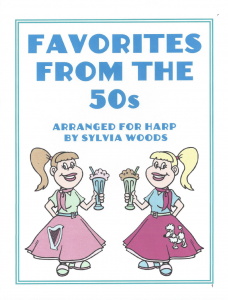
Depending on your generation, Sylvia Woods’ new book, Favorites from the Fifties, could be a stroll down memory lane or a history lesson of post WWII pop music. She has sorted the 40 selections into seven categories. Seven of the pieces are presented twice in order to accommodate lever harps tuned to C or E-flat. Two others are presented twice because they offer multiple levels of difficulty.
The first group includes three songs made famous by Elvis Presley. “Don’t Be Cruel” and “(Let Me Be Your) Teddy Bear” are both in C and have no lever or pedal changes. The advanced beginner arrangement of “Love Me Tender” has no lever changes, but pedal harpists will have a few changes. The intermediate arrangement has five lever changes within the music that give it richer harmonies and make it slightly more difficult. It can be played as a duet with the previous arrangement.
There are 12 tunes by Crooners and Teen Idols. “Donna” and “Hot Diggity” have no lever changes. The music and lever changes in “Magic Moments,” “Memories Are Made of This,” and “That’s Amore” are easy. “Fly Me to the Moon” is a little more challenging with more pedal and lever changes. “Catch a Falling Star” has a more rhythmic left hand accompaniment. “Put Your Head on My Shoulder” has two tuning versions and is one of several pieces intended to be played with swing, which she explains in the introduction. The last three in this group, “The Twelfth of Never,” “Venus,” and “You Send Me” are just a shade more difficult, but still sight-readable for intermediate players.
Most of these arrangements are pretty simple, but whenever possible, Ms. Woods uses the “hook” that is identified with the song such as the rhythmic pulses on “Dream Lover.”
In the Doo-Wop Group for example, the hook in “Goodnight Sweetheart, Goodnight” makes you want to sing along with the “doe doe dee o doe’s” (remember “Three Men and a Baby?”) You’re on your own for imitating the nasal, high-pitched voices associated with “Silhouettes.” Woods offers two versions of the final two measures, but the D-sharp would work for harps tuned to C or E-flat. There are several levers to move to accomplish the key change in the last eight measures of “Tears on my Pillow.”
Others in the Groups and Duos section are introduced with a classic from the Everly Brothers, “All I Have to Do is Dream,” presented for either tuning. The arrangement is simple yet appealing. Another Everly Brothers tune, “Devoted to You” features the melody below the harmony in the right hand. “Come Softly to Me” and “Lollipop” have no lever changes. The former is pretty repetitive; the arranger encourages you to make a popping sound on the latter. Buddy Holly’s “Everyday” is presented for both lever harp tunings. “26 Miles” finishes this category.
There are quite a few pop standards in the Movies, Broadway, and Television section. “Three Coins in the Fountain” is presented for both tunings and has a few more interesting harmonies. There is an easy arrangement of “Edelweiss” with no lever changes for small harps that don’t go below fifth octave C, as well as an intermediate arrangement. They can be played together as a duet. “Singin’ in the Rain” includes the familiar hook to start and end the piece that brings to mind iconic images of Gene Kelly tap dancing in the rain.
“Getting to Know You” is an upbeat and pleasant arrangement with several manageable lever changes. “One Hand, One Heart” also has multiple lever changes. The intro and left hand accompaniment on “Goodnight My Someone” simulates the cross-hand piano playing of the character Amaryllis in the movie and stage version of “The Music Man.” The left hand plays an octave higher than the right hand at the end of the jaunty rendition of “The Wells Fargo Wagon.” There may not be much demand for “It’s Howdy Doody Time” and the theme from “Dennis the Menace,” but they are included nevertheless.
The last section is sort of a catch-all category. “How Much Is That Doggie in the Window” has a little more variety in the left hand accompaniment, but is still quite easy and has no lever changes. There are also no lever changes in “Day-O (The Banana Boat Song)” or “The Lion Sleeps Tonight.” The latter has sections of eighth notes played evenly and also in a swing rhythm. “Tennessee Waltz” and “Tequila” are presented for both lever harp tunings. “Witch Doctor” and “Scarlet Ribbons” complete the selections.
Chord symbols are included above the staff on every song. Pedal markings are below the staff. Lever changes are indicated both by diamond-shaped notes and by octave wording in the middle of the staff. Lyrics are written where they belong in the music. Kudos to Sylvia Woods for including lyrics in the same way piano music has been written for years.
Many of these arrangements can be played on lever harps with fewer than 26 strings. Pedal harpists may want to embellish or expand these arrangements to cover a wider range. Fingering is suggested where it is helpful.
This collection has a lot of potential. The music isn’t difficult but provides lots of crowd-pleasing tunes, especially if your audience is baby boomers or older. This book could be useful when playing in a retirement community. There are fun facts and trivia from the ’50s at the back of the book that could also be used to entertain your audience. It is available in a printed book or as a PDF download. Find a poodle skirt and start the year off by playing the music of the ’50s. •
Jan Jennings is the music review editor for Harp Column and is the author of The Harpist’s Complete Wedding Guidebook and Effortless Glissing. Email her at
mail@harpbiz.com.






